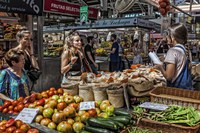
Food systems require urgent and profound transformation to become sustainable, both in Europe and worldwide. Social innovation plays a pivotal role in transforming today’s food systems into ones that are economically and socially feasible, and sustainable within planetary boundaries. This briefing presents the results of a systematic examination of emerging social innovations across the food chain, conducted using horizon scanning, a tool to detect early signs of potentially important developments. It offers insights into the experimentation taking place in alternative ways to produce, trade and consume food.

The EU chemicals strategy for sustainability aims to ensure that chemicals are ‘produced and used in a way that maximises their contribution to society … while avoiding harm to the planet and to current and future generations’ (EC, 2020). Building sustainability dimensions into products’ design phase can support the delivery of these objectives. Key features of sustainable products include chemical safety, recyclability and a low environmental impact. This briefing describes approaches that are safe and sustainable by design and identifies enabling conditions, which support their uptake, and the related challenges and opportunities.

Land and soil provide vital resources to society such as food, feed, fuel, fibres and shelter. They also provide ecosystem services that support production functions, regulate the risk of natural hazards, and provide cultural and spiritual benefits. By using land, society alters and modifies the quantity and quality of these services, and the intrinsic potential for land benefits to mankind. To better manage its use of land and associated processes, society needs a systems (i.e. integrated) view on land. This briefing proposes an analytical framework that aims at developing a strategy for monitoring and integrated assessment of the state of land and its key resources.

The EU Biodiversity Strategy to 2020 calls on Member States to carry out a mapping and assessment of ecosystems and their services (MAES, Maes et al., 2013). As such, an EU-wide ecosystem assessment was launched to provide harmonised information on the condition of ecosystems and biodiversity, and their capacity to provide ecosystem services. The assessment will provide data for the final evaluation of the EU biodiversity strategy in 2020.
This briefing presents recent progress in mapping broad ecosystem types and their associated habitats at European level. This mapping uses spatially explicit land cover information, mostly based on the Copernicus service portfolios, the habitat classification of the European Nature Information System EUNIS (EEA, 2017) and other spatially referenced data sets. The work is also an essential input to the EU-level mapping and assessment of ecosystems and their services following the MAES analytical framework (Maes et al., 2018).

From the perspective of European consumption, textiles have on average the fourth highest negative life cycle impact on the environment and climate change, after food, housing and mobility. A shift to a circular textile production and consumption system with longer use, and more reuse and recycling could reduce those impacts along with reductions in overall consumption. One important measure is circular design of textiles to improve product durability, repairability and recyclability and to ensure the uptake of secondary raw materials in new products.
Document Actions
Share with others